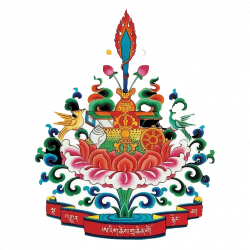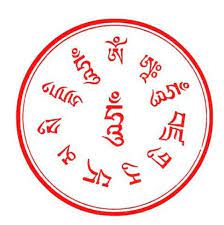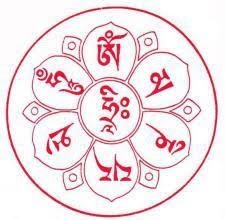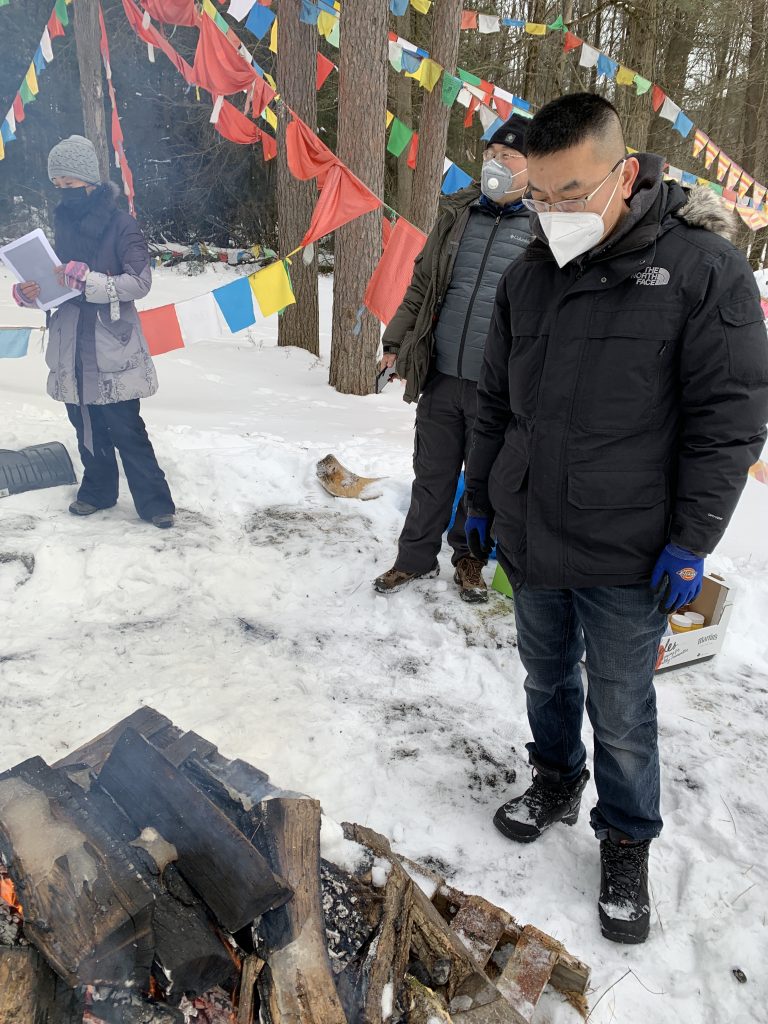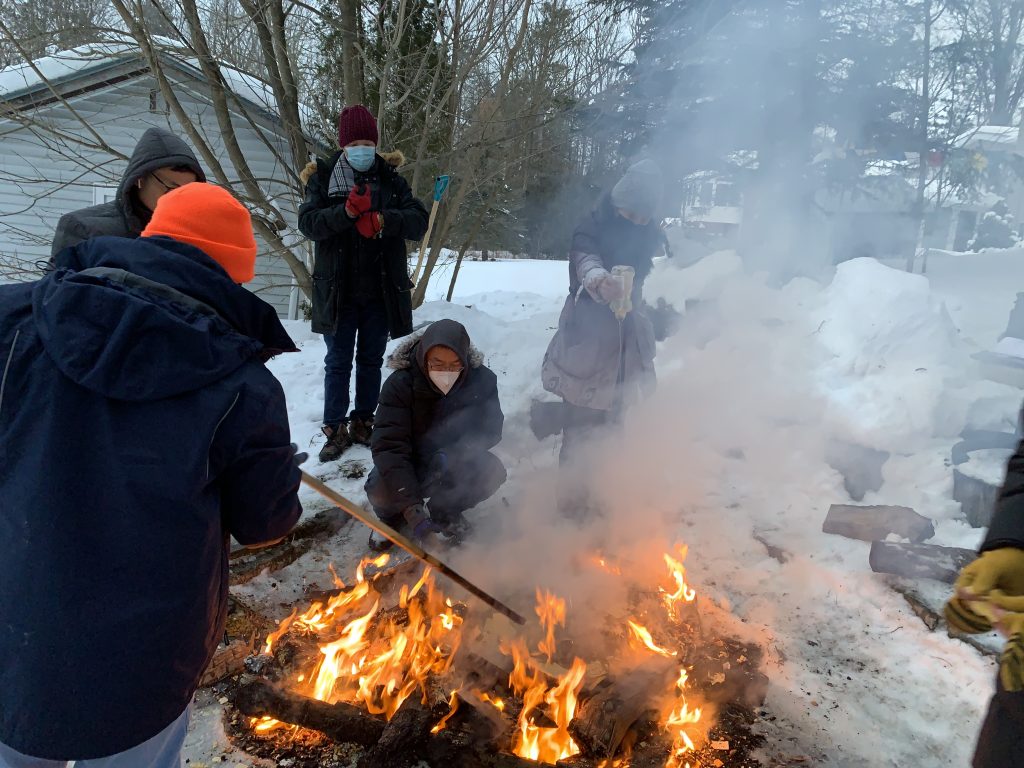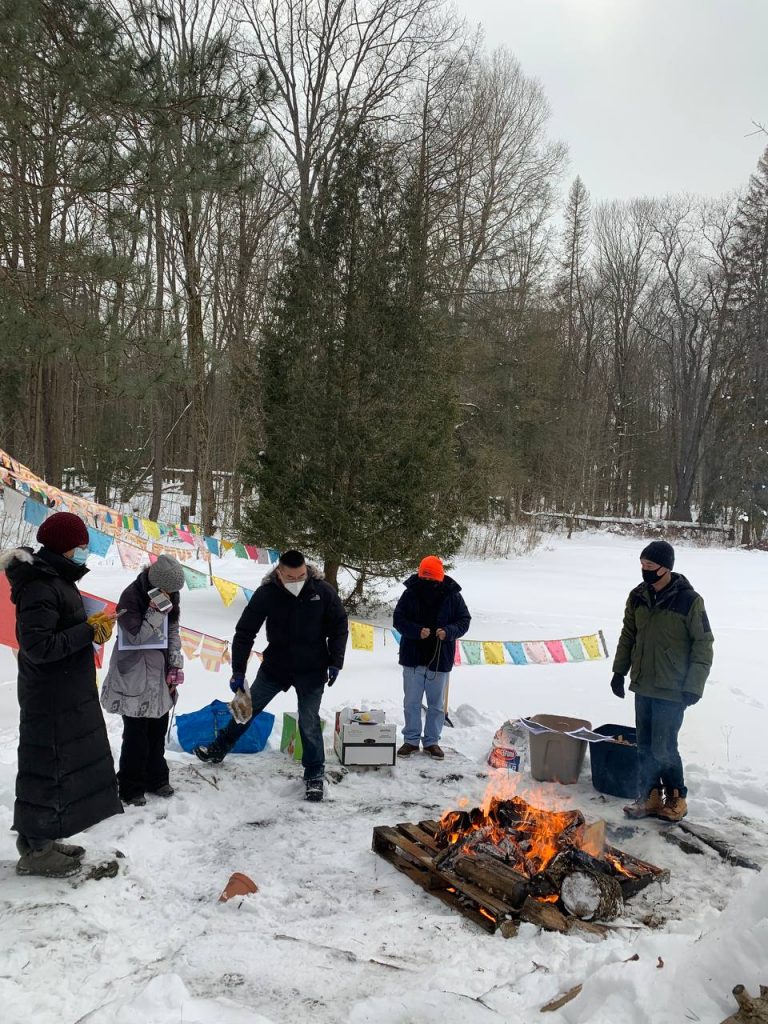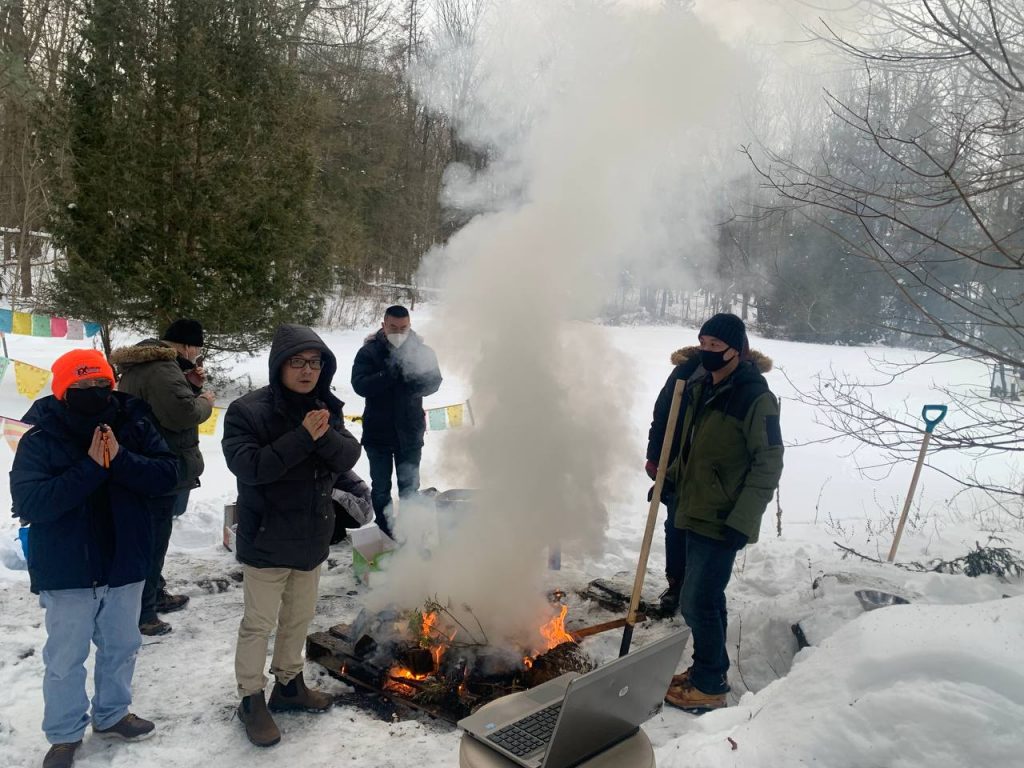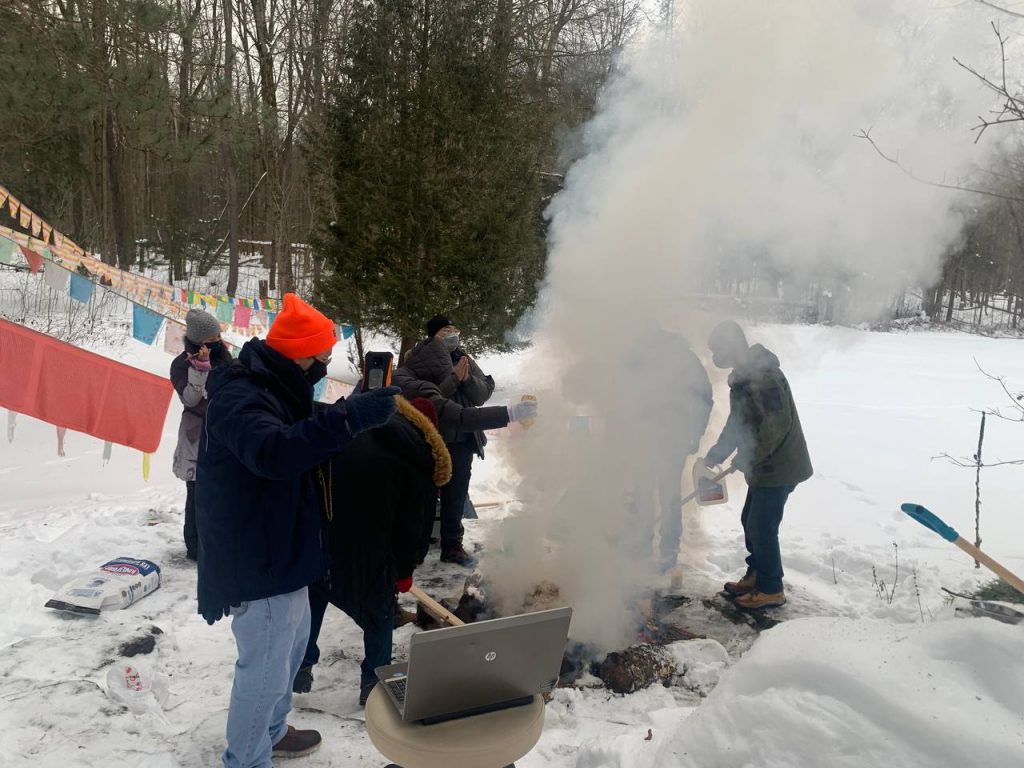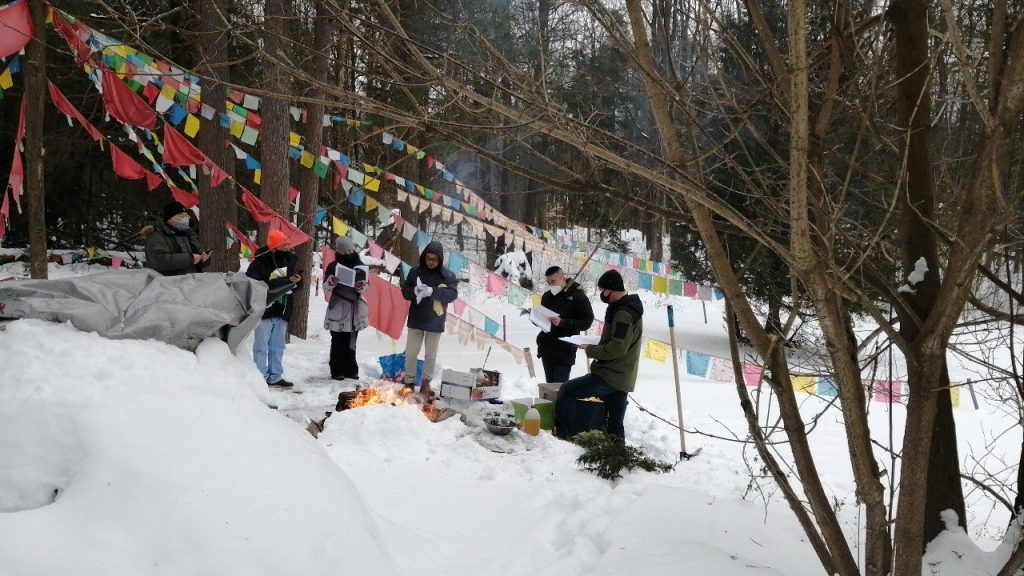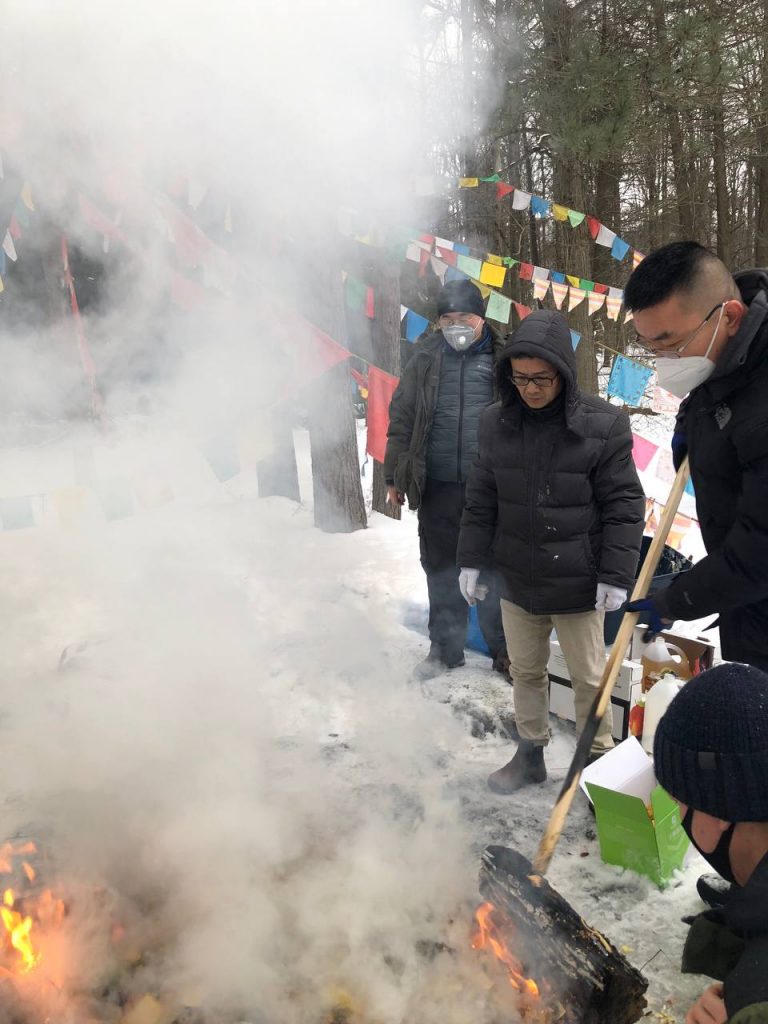
We are honored to invite H.H. Lhoga Rinpoche, the throne holder of Kathog, to visit the Kathog Ati Buddhist Center in Canada. This once-in-a-millennium opportunity coincides with the establishment of our new center, so we have specially requested H.H. Rinpoche to consecrate and bless the new center and transmit a series of extraordinary terma treasures. Through these auspicious conditions, we pray for the eternal stability of the Buddha’s teachings, for all beings to be free from suffering and attain happiness, and for world peace.
All the teachings transmitted this time belong to the supreme lineage of the Kathog Vajra Throne, the source of the Nyingma school. Since its founding by Kathog Dampa Deshek, the Kathog teachings have left an unprecedented record of one hundred thousand rainbow body attainments in the history of Tibetan Buddhism. The lineage has endured without decline, benefiting countless beings. We again pray for the blessings of all the Kathog lineage masters, and for the auspicious success of H.H. Lhoga Rinpoche’s Dharma tour.

To help those with karmic connections understand the content of these transmissions and develop sincere devotion, we provide the following explanation of the teachings.
Planned Teachings:
November 22, 2024, at the Kathog Monastery Ati Dharma Center in Canada:
Group practice of the Vajrakilaya Puja from the terma of Kathog Great Tertön Terdün Dorje, to consecrate and bless the center’s supports and representations of the Three Jewels.
In the evening, transmission of the Yellow Jambhala empowerment from the terma of Kathog Great Tertön Rigdzin Longsal Nyingpo.
November 23, 2024, at the Kathog Monastery Ati Dharma Center in Canada:
Transmission of the Uncommon Three Roots empowerment of the Luminous Vajra Treasury of Dharmadhatu from the terma of Kathog Great Tertön Rigdzin Longsal Nyingpo:
Lama: Guru Padma Jvala (Blaze)
Yidam: Wrathful Guru Rinpoche
Dakini: Red Lion-Faced Dakini
November 24, 2024, at the Kathog Monastery Ati Dharma Center in Canada:
Transmission of the Uncommon Great Illusory Net empowerment from the terma of Kathog Great Tertön Rigdzin Longsal Nyingpo.
November 29, 2024, at Riwoche Temple in Canada:
Transmission of the non-dual lineage empowerment of the Amitabha practice from the pure vision of Kathog founder Kathog Dampa Deshek and the Amitabha practice from the terma of Kathog Great Tertön Rigdzin Longsal Nyingpo, as well as the transmission and group practice of Phowa.
November 30, 2024, at Riwoche Temple in Canada:
H.H. Rinpoche will lead the group practice of Phowa.
December 1, 2024, at Riwoche Temple in Canada:
H.H. Rinpoche will lead the group practice of Phowa.
Lineage Origins
Kathog Dorje Den, meaning “Kathog Vajra Throne”, is the source of the Nyingma tradition within Tibetan Buddhism. It was established in 1159 CE by Kathog Dampa Deshek, an emanation of Amitabha Buddha. With a history spanning 865 years, its monastic branches and lineage have spread across the globe. It is the practice site of dakini Yeshe Tsogyal, the foremost among the five sacred sites. Moreover, it is hallowed as the place where Guru Padmasambhava and his disciples stayed for twenty-five days, personally descending to consecrate and bless it thirteen times.

Due to the auspicious circumstances of Guru Rinpoche’s thirteen consecrations, over Kathog Vajra Throne’s nearly 900-year history, many high monks and great masters have emerged to safeguard and transmit the Kathog lineage, including the Thirteen Lamas Family Lineage, the Thirteen Trungpa Family Lineage, and the Thirteen Moktsa Family Lineage. Throughout generations, these eminent masters have dedicated themselves to propagating the Nyingma teachings and preserving the Kathog lineage, profoundly influencing Tibetan Buddhist practitioners worldwide in recent times.
Notably, Kathog Khenchen Gyaltsen Ozer, H.H. Mahasattva Kathog Thrimed Zhingkyong, H.H. Moktsa Rinpoche, H.H. Lhoga Rinpoche, H.H. Jamyang Rinpoche, Khenpo Jangyahng Gyaltsen, Khenpo Asong Dampa, and numerous other Kathog Rinpoches have made substantial contributions to Kathog Vajra Throne’s revitalization in modern times. Throughout its nearly thousand-year history, Kathog Vajra Throne has experienced many ups and downs, but thanks to the steadfast perseverance and protection of its lineage masters, it still shines atop the snowy peaks to this day.
Biography of the Lineage Holders
A Brief Introduction of Kathog Dampa Deshek, Founder of Kathog Monastery
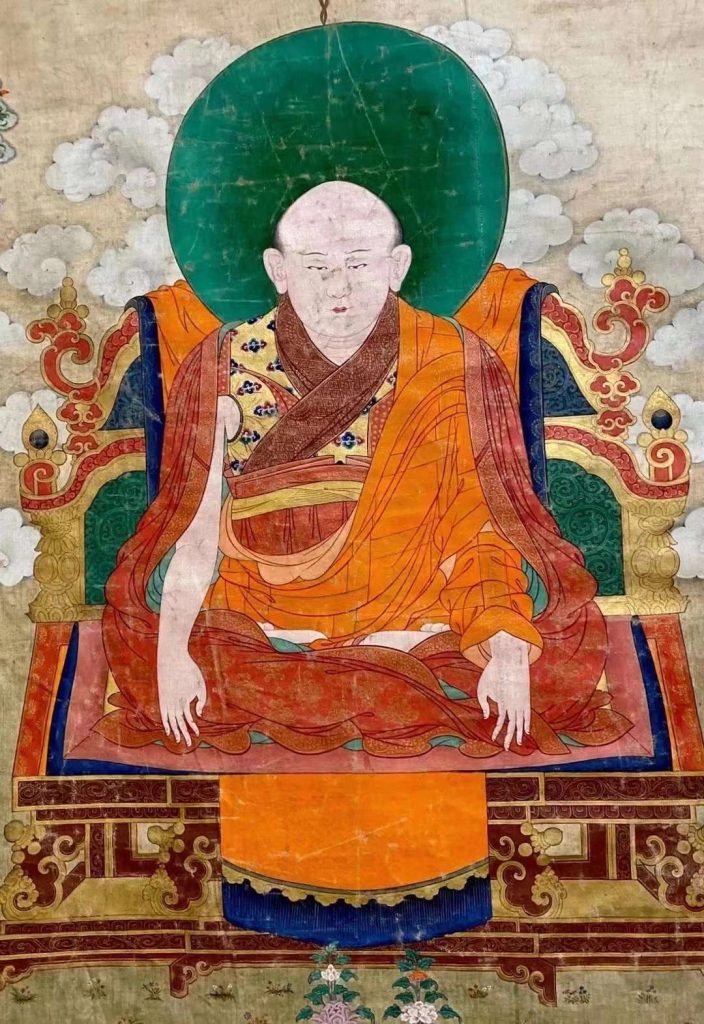
Kathog Dampa Deshek was an authentic manifestation of Amitabha Buddha and Manjushri Bodhisattva. His appearance marked the beginning of rainbow body attainments at the Kathog Vajra Throne in the Tibetan plateau.
At the age of twenty-nine, his guru Tsangtonpa prophesied: “You will attain the rainbow body practicing in Kongpo. Go to Kathog in Kham, where Guru Padmasambhava stayed for twenty-five days, consecrated thirteen times, and where the translator Vairotsana practiced. The Buddha’s teachings will endure there for a thousand years.”
When conditions matured, Kathog Dampa Deshek led two disciples to Kham in search of Kathog. In the Earth Rabbit year of the third Rabjung cycle (1159 CE), all auspicious conditions were fulfilled for Kathog Dampa Deshek to establish Kathog Monastery. During the construction period, over a thousand Dharma seekers worked on building the monastery during the day and studied the teachings at night, sometimes combining study with practices to purify obscurations.
After two years, by the Female Metal Dragon year (1160 CE), the monastery’s construction was completed. During the auspicious consecration ceremony, rainbows like jeweled canopies appeared in the clear sky, flower rains descended, wondrous sounds spontaneously arose, manifesting auspicious signs of the wisdom deities’ presence, moving the hearts of all sentient beings.
Subsequently, the venerable master extensively turned the wheel of Dharma, established a monastic college for study and practice, nurturing countless monks over the years. From this time onward, Kathog embarked on a glorious history of flourishing in both doctrinal teachings and experiential realizations.
On the fifteenth day of the month of Uttaraphalguni (the fourth month) in the Water Rat year of the third Rabjung cycle (1192 CE), at Drala Gongkha Rewa, the venerable master entered parinirvana facing west, with his hands forming the meditation mudra of resting in the nature of mind. At that moment, the earth suddenly trembled, nine great sounds occurred, a rainbow bridge appeared in the western sky, with one end connecting to his dharma body. Flower rains descended from the clear cloudless sky, manifesting many such miraculous signs. All who saw, heard, contemplated, or perceived these events planted seeds of liberation, and all sentient beings became devout believers.
Tsangtonpa Dorje Gyaltsen and three hundred bhikshus presided over the cremation rituals of his dharma body. On the left side of the cremation platform, a yellow flower suddenly grew, perfectly matching all the signs of the completion of the path’s warmth stage as described in the tantras.
Notably, the skull remained unburned, displaying images of the Eleven-Faced Avalokiteshvara and the Five Deities of Amoghapasha on the front; the Five Dhyani Buddhas and Four Heavenly Kings on the right; the Ten Wrathful Vajras and Samantabhadra on top; Guhyasamaja on the left; Manjushri inside; Vajrakilaya on the back; as well as miraculously raised, exquisite, and majestic images of the Three Principal Ones—Shakyamuni, Avalokiteshvara, and Vajrapani—that can still be venerated today; and over a thousand relics and other auspicious signs.
At Dhari Chokyi Gongkha Rewa (present-day Genbeng), they built the founder’s stupa and the Tsangkhang Gongkha Rewa (Dharma Institute) with bricks and stones, successfully completing the posthumous affairs.
Throughout his life, the venerable master’s activities to benefit sentient beings never ceased. Not only did he nurture countless monastic talents, but he also left behind a rich collection of writings, truly manifesting the source of the lineage.
From the venerable master until now, Kathog Monastery has had Dharma heirs and masters’ lineages, with disciples propagating the teachings throughout India, China, Mongolia, Dali, Ü-Tsang, Kham, and other regions. However, as many of these Dharma heirs were wise and virtuous practitioners who avoided fame during their lifetimes, their historical records and biographies are largely undocumented. Moreover, due to the passage of time, it is no longer possible to discuss them in detail.
Nevertheless, we practitioners, especially those of the Nyingma school and Kathog lineage, should always remember in our minds the kindness of these lineage masters, not only because of their immense merits of genuine practice and realization but also because they are the very foundation of our attainment of enlightenment!
A Brief Introduction of the Great Terton Rigdzin Longsal Nyingpo of Kathog

Rigdzin Longsal Nyingpo was born in the Wood Ox year (1625 CE). At birth, he was embraced by the Kathog lineage master and great accomplished one Dampa Gyatso, who bestowed empowerment upon him in the mandala of Wrathful Guru Padmasambhava, giving him the secret name Wangdrak Gyatso.
At the age of 22, on his way to Kathog, he encountered the great yogi Ga Chokyong Gyatso and received the Mahamudra teachings of the Kathog lineage. He obtained many teachings, including the uninterrupted transmission of the profound meaning, from the great accomplished one Ado Gonchok Gyatsen. During his three years at Kathog, he studied scriptures and treatises under 13 great masters.
At the age of 29, he went to Bupo to stay with the great tertön Rigdzin Tendün Dorje for three years, receiving the uncommon blessings of the four empowerments in their entirety. He was entrusted as the lineage holder of Tendün Dorje’s profound terma teachings. Based on numerous terma objects of body, speech, and mind activities—dharma hats, robes, and prophecies—he was officially recognized as the combined incarnation of two of Guru Rinpoche’s twenty-five great disciples: Longdrol Genchok Chönyi, and Ma Rinchen Chok. He was also prophesied by Guru Padmasambhava in terma teachings as a great tertön.
At the age of 32, he received the terma catalog and from then on continuously opened the door to revealing extraordinary terma teachings. When the doctrinal and realization teachings at Kathog were declining due to various circumstances, he was invited by the Chieftain of Dege and entrusted with revitalizing Kathog. Thereafter, he resided at Kathog, propagating the teachings, nurturing monastic talents, and restoring and constructing temples and supports of the Three Jewels.
Throughout his life, he revealed terma teachings on sixteen occasions. These terma teachings encompassed a wide range of profound and extraordinary instructions, from preliminary practices to main practices, including the generation and completion stages of the Three Roots (guru, yidam, and dakini), as well as the practices of channels, winds, and bindus, and Dzogchen practices of Trekchö and Tögal. The quantity is vast, the meaning profound, and the blessing power immense. These teachings are still preserved in their entirety, and due to the purity of their uninterrupted lineage and empowerments, practitioners continue to show signs of realization, benefiting countless beings.
In 1680, at the invitation of the Chieftain of Dege, the master was returning to Kathog Monastery from the sacred place Tsopu when he passed through a place called Ari (east of Kathog). In his all-knowing wisdom mirror, he recognized an eight-year-old boy, a descendant of the Trungpa lineage, as the lineage holder of the Longsal Vajra Essence. He transmitted to him all the empowerments and pith instructions of the terma teachings, making him the dharma heir of the terma lineage. This boy later grew up to become the renowned great self-liberated accomplished yogi among the lineage masters of Kathog Vajra Throne, Trungpa Namkha Gyatso. The great tertön Taksham Dorje had prophesied in his terma: “When the mind emanation of Dampa Deshek appears in the east of Kathog with the name Namkha.” This also confirms that Trungpa Rinpoche was the mind emanation and reincarnation of Kathog Dampa Deshek.
It is prophesied in the terma teachings: “In the degenerate age, especially in secluded regions where the Buddha’s teachings have not yet flourished, there will be even more special circumstances and blessings.” The great tertön Rigdzin Longsal Nyingpo, the true refuge for beings in this degenerate age, spent his life propagating the termas of Buddha’s teachings, benefiting countless beings to this day. His kindness is as vast as the sun illuminating all beings. Many contemporary great masters of the Nyingma school have attained realization by practicing the terma teachings revealed by the great tertön Rigdzin Longsal Nyingpo—”The Supreme Guide to the Heart Essence of the Great Perfection”—and have used it to widely guide fortunate disciples, with the lineage spreading globally.
The venerable master entered parinirvana on the 23rd day of the Monkey month in the Water Monkey year of the 12th Rabjung cycle (June 23, 1692, in the Tibetan calendar). During the cremation of his body, numerous extraordinary relics and all the auspicious signs described in the Dzchogchen tantras appeared. His direct disciples built an extraordinary reliquary stupa for him and enshrined it in Longsal Nyingpo’s retreat room, along with a life-size statue that the master himself had constructed and consecrated, near the limb-preserving stupa built by the great translator Vairotsana at the “Gebum” (hundred thousand bodies) sacred site of Kathog.
(The above content is excerpted from “The Lamp of the Path to Liberation: A Commentary on the Preliminary Practices of the Longsal Vajra Treasury by the Great Tertön of Kathog” authored by Trungpa Rinpoche)
An Introduction to Kathog Great Tertön Rigdzin Longsal Nyingpo’s Terma Teachings
The “Oral Recitation Ritual for Guiding the Preliminary Practices of the Luminous Vajra Treasury of Dharmadhatu” is one of the terma teachings of the great tertön Rigdzin Longsal Nyingpo. It serves as the preliminary practice for the essence of Longsal’s Dzogchen terma teachings and belongs to the Vajra Treasury terma cycle along with Longsal’s “Three Roots Vajra Treasury” and “Three Kayas Vajra Treasury” series. This terma cycle was directly transmitted to Rigdzin Longsal Nyingpo by Guru Padmasambhava and the wisdom dakini Yeshe Tsogyal, which is a special method of transmission.
Although centuries separate Guru Rinpoche, Dakini Yeshe Tsogyal, and Longsal Nyingpo, this does not affect the transmission of the teachings—this is the unique aspect of the uncommon terma transmission. These Longsal Nyingpo terma teachings have been passed down through generations of lineage masters without interruption, and the lineage remains very pure. More importantly, now is precisely the time when the aspirations and activities of the great tertön Rigdzin Longsal Nyingpo are flourishing.
(The above content is excerpted from “The Lamp of the Path to Liberation: Commentary on the Preliminary Practices of the Longsal Vajra Treasury by the Great Tertön of Kathog” authored by Trungpa Rinpoche)
Due to the ripening of bodhicitta and aspirations made in previous lives, the activities of Longsal’s terma teachings to benefit beings are spontaneously accomplished and widely flourishing. For us fortunate disciples to encounter these teachings is truly the result of accumulating merit over many lifetimes. If we can practice diligently to attain enlightenment, it will be a great virtue of repaying the kindness of the guru and Three Jewels above, and of resolving long-standing karmic debts with enemies and creditors below.
Merits of the Practices
Empowerment of the Non-Dual Lineage of the Pure Vision Amitabha Practice of Kathog Founder Kathog Dampa Deshek and the Amitabha Practice of Kathog Great Tertön Rigdzin Longsal Nyingpo

The lineage of this Amitabha practice empowerment is the pure vision teaching of Kathog Dampa Deshek Sherab Senge, an emanation of Amitabha Buddha as prophesied by buddhas and bodhisattvas. Prophecies regarding Kathog Dampa Deshek’s accomplishments are documented in tantras such as “The Collection of the Profound Meaning of the Supreme Dharma” and “The Wish-Fulfilling Casket,” which contain prophecies for individual saints.
Kathog Dampa Deshek is recognized as the genuine Dharma King among lineage masters in the Nyingma lineage of Tibet, an emanation of many accomplished sages such as Shantideva. In a state of great pure samadhi, the venerable one directly saw Tathagata Amitabha Buddha and received the uninterrupted blessing of his wisdom intent. Amitabha Buddha personally bestowed upon him the empowerment and lineage of the supreme inner secret Mahayoga-style Amitabha practice.
This lineage was transmitted from Kathog Dampa Deshek to Tsangton Dorje Gyaltsen, and subsequent lineage masters include Jampa Beng, Chen Nga Wa Rinpoche, and Supreme Mutön Sonam Bengpa. In the pure vision of all these venerable masters practicing this Amitabha sadhana, the pure mandala of Amitabha’s Sukhavati always manifests—this is the power of the sublime Dharma and pure lineage. Therefore, this Amitabha practice has guided countless beings to rebirth in Sukhavati. Many Kathog masters have also been reborn in the Western Pure Land, known by names such as Wisdom Treasury Bodhisattva, Wish-Fulfilling Treasury Bodhisattva, Moon Treasury Bodhisattva, Great Bliss Sprout Bodhisattva, and so on.
This uninterrupted, pure, and sublime teaching—the ritual of Kathog Dampa Deshek’s pure vision Amitabha practice—was revealed from terma by Kathog Vidyadhara Great Tertön Rigdzin Longsal Nyingpo, who is the reincarnation of Chiktsa Gönpa Rinpoche, one of the four prophesied ones of Kathog, when conditions ripened. From then on, it became the sublime lineage that unifies the blessings of Longsal’s Vajra Treasury Amitabha practice and Kathog Dampa Deshek’s pure vision lineage, without duality or distinction.
Mipham Rinpoche states in his “Instructions on the Pure Land”: “Whoever hears the name of Tathagata Amitabha Buddha and wishes to be reborn in his pure land can achieve rebirth there. This is due to the aspirations made in the past by the bhikshu named Dharmakara before the Tathagata Lokeshvararaja, to perfectly uphold and accomplish the virtues of countless hundreds of thousands of millions of Buddha-fields, and to create an even more sublime pure land. To fulfill these vast aspirations, he practiced immeasurable bodhisattva deeds. Now he has completely fulfilled all his past aspirations and attained accomplishment. He has attained Buddhahood in the pure land called Sukhavati and constantly teaches the Dharma. Therefore, by the power of the Buddha’s aspirations, one can easily be reborn in the pure land.” The virtues of Amitabha Buddha and his pure land are extensively documented in ancient scriptures and treatises. The methods for accomplishing this have become sublime pith instructions for swift liberation for later practitioners.
Kathog Great Tertön Rigdzin Longsal Nyingpo’s Yellow Jambhala Empowerment

In Tibetan Buddhism, Yellow Jambhala is the foremost among all wealth deities, the collective manifestation of all wealth deities. Yellow Jambhala is a great bodhisattva who has reached the bhumis, manifesting as a worldly wealth protector. In essence, he is an emanation of Buddha Shakyamuni, appearing according to beings’ capacities to liberate them. Yellow Jambhala’s body, speech, mind, activities, and qualities further emanate as the Five-Colored Jambhalas: Yellow Jambhala represents mind, Red Jambhala represents speech, White Jambhala represents body, Blue Jambhala represents activities, and Green Jambhala represents qualities.
The Yellow Jambhala practice possesses sublime virtues and benefits. By practicing it with sincere devotion according to the instructions, one can receive Yellow Jambhala’s blessings and protection. From a worldly perspective, it enables tantric practitioners to have the resources to spread the Dharma and benefit beings, without being constrained by life’s difficulties. It brings benefits in terms of reputation, career, wealth, etc., eliminates illness and suffering, increases lifespan and merit, thus providing the causes and conditions of merits, as well as convenience to pursue the path with peace of mind.
Ultimately, it can perfect a practitioner’s two accumulations of merit and wisdom, leading to rebirth in Sukhavati, the Pure Land of Great Bliss. Therefore, practitioners should also generate the supreme bodhicitta, diligently practice generosity, and be careful in adopting virtues and abandoning non-virtues—this is the approach of a practitioner with correct faith. The path of practice is long, but in essence, it is about accumulating merit and purifying obscurations. The Yellow Jambhala practice is a sublime method for accumulating the resources of merit and wisdom. Those who practice it correctly will surely fulfill their wishes.
Kathog Great Tertön Rigdzin Longsal Nyingpo’s Terma Teaching—The Uncommon Three Roots Empowerment of the Luminous Vajra Treasury of Dharmadhatu
The Luminous Vajra Treasury of Dharmadhatu is a very important part of Kathog Great Tertön Rigdzin Longsal Nyingpo’s terma teachings. It can be said that most practitioners of the Kathog lineage are practicing the Vajra Treasury preliminary practices and Dzogchen.
The Three Roots series of the Longsal Vajra Treasury being transmitted this time is a profound terma revealed by the great tertön Rigdzin Longsal Nyingpo on the 10th day of the first Tibetan month in 1658 CE from the mountain casket at Immovable Vajra Mountain in Lithang.
The Three Roots are the fundamental stages in the tantric practices of the Nyingma school of Tibetan Buddhism. The source of all blessings is the supreme guru, the source of all siddhis is the sublime yidam, and the source of all activities is the wisdom dakini. In the practices of yidams and dakinis, due to one’s own lineage and various circumstances, each tradition has its own main deity practice, which becomes the uncommon and sublime Three Roots practice of yidam and dakini within their respective traditions.
The seven-part series of Longsal terma teachings includes preliminary practices, generation and completion stage practices of the Three Roots, dakini and protector practices, as well as the series of Trekchö and Tögal practices of the supreme Dzogchen, all complete and perfect. Among them, the first series, which is the Three Roots practice being transmitted this time, has Guru Padma Jvala as the lama, Wrathful Padmasambhava as the yidam, and the Red Lion-Faced Dakini as the dakini.
In the Kathog lineage, although there are many Three Roots terma practices from various tertöns, the practices of Terdün Dorje and Longsal Nyingpo have been particularly widely propagated. Both two great tertöns received personal prophecies from Guru Padmasambhava and are among the hundred great tertöns. Their terma teachings have pure lineages and great blessing power; in the process of revealing terma teachings, they have never violated the dependent origination of these termas. Therefore, many practitioners have achieved realization through this lineage’s practices, and there are few obstacles during the practice process. Especially, the practices of Wrathful Guru Rinpoche as the yidam and the Red Lion-Faced Dakini are particularly effective for swiftly removing obstacles and receiving blessings in this degenerate age, eliminating various harms caused by non-human beings, and dispelling the great obstacles arising from the five poisons of ignorance that prevent practitioners from peaceful practice.
Lama: Guru Padma Jvala
The lama for this practice is Guru Padma Jvala (Blaze), belonging to the Three Kayas of peaceful and wrathful practices of the Vajra Treasury. In the mandala of the five wisdom manifestations, the Buddha with perfect marks and signs emanates as the main deity Guru Padma Jvala. The Vajra Treasury states: “In the perfect marks and signs, the Bhagavan, the emanated vidyadhara Guru Padmasambhava, with a white-red body radiating brilliant light, sits in the vajra posture with the appearance of an eight-year-old child,” describing the posture and attire of the deity to be visualized. It further states: “Representing the perfect grounds and paths of enlightenment, all the virtues and activities of body, speech, and mind, the perfect yidam, the vidyadhara buddha body.”
Guru Padma Jvala’s own body and the mandala are complete with the eight manifestations of Padmasambhava, the eight great bodhisattvas, buddha fathers and mothers, and other peaceful and wrathful deities. This belongs to the category of generation and completion stage practices and is also one of the practices for realizing the purity of the two truths and great equality in the view of inner secret unsurpassed Mahayoga.
Yidam: Wrathful Guru Rinpoche

Wrathful Guru Rinpoche is one of the fierce emanations of Guru Padmasambhava. This deity has one face and two arms, with deep red skin color, a wrathful expression, three round eyes, sharp fangs, open mouth with bared teeth and curled tongue, emitting a sound like a thousand thunderclaps. His beard and eyebrows blaze like fire, his yellow hair stands upright, he wears a crown of five dry skulls, a garland of fresh wet human heads around his neck, and is adorned with elephant skin, human skin, tiger skin, and black snake chains and ropes as ornaments. His right hand holds aloft a vajra, his left hand holds an iron scorpion. He tramples on male and female demons, standing majestically amidst blazing wisdom flames, able to subdue evil spirits in all directions.
Cultivating this practice can perfect all kinds of Buddhist activities. It has uncommon sublime virtues for subduing obstacles caused by the harm of human and non-human evil spirits such as nagas, ghosts, and rakshasas. It can eliminate the three poisons of greed, hatred, and ignorance of beings in the six realms with great wrathful power, swiftly attaining Buddhahood and benefiting all sentient beings.
This Wrathful Guru Rinpoche terma practice is particularly timely now, as we are in the degenerate age when wars, famines, diseases, and other calamities caused by the five poisons in beings’ minds are arising in great numbers. Thus, Kathog Great Tertön Rigdzin Longsal Nyingpo manifested to reveal this terma. Just hearing the names of Pema Wangdrak, Longsal Nyingpo, and others can subdue all demons and spirits, including the eight classes of gods and nagas. The power and activities of the great tertön are indistinguishable from those of Wrathful Guru Rinpoche.
This Wrathful Guru Rinpoche practice belongs to the most secret level of outer and inner tantra. Many great masters of the Kathog lineage have taken this practice as their personal uncommon yidam practice and practiced it throughout their lives. This uncommon sublime lineage of Wrathful Guru Rinpoche was directly transmitted by Guru Rinpoche to Kathog Rigdzin Longsal Nyingpo’s previous incarnation—Longdrol Genchok Chönyi, buried as a terma with the aspiration: “In the future, when conditions ripen in the degenerate age, a great tertön will reveal this terma, benefiting countless beings.”
We are now in the degenerate age of the five defilements; beings are filled with intense greed, hatred, and ignorance, and practitioners face the same problems, with minds constantly aflame with afflictions, difficult to pacify. Wrathful Guru Rinpoche is the emanation of Guru Rinpoche that subdues these afflictions. Guru Rinpoche in wrathful form can cut through practitioners’ mental and emotional obstacles. This time, due to auspicious conditions, we have the opportunity to connect with the outer and inner secret practice ritual of Wrathful Guru Rinpoche that flows from the luminous Dharmadhatu of wisdom intent. The profound causes and conditions of this are inconceivable, and we should cherish this Dharma connection.
Dakini: Red Lion-Faced Dakini

The Lion-Faced Dakini is one of the most important wisdom dakini protectors in Tibetan Buddhism. Her primordial dharmakaya is the Buddha of Prajñā (Wisdom), her sambhogakaya is Vajravārāhī, and her nirmanakaya is the Lion-Faced Dakini. She is one of the supreme activity wisdom dakini practices of the Nyingma school and an indispensable dakini protector in Guru Padmasambhava’s activities.
When beings in this degenerate age, due to the manifestation of karma, wander aimlessly in samsara blown by the karmic winds, suffering various pains due to improper mental conduct, practitioners with bodhicitta, by virtue of being able to cultivate this sublime practice of the Lion-Faced Dakini, can instantly eliminate numerous obstacles for sentient beings.
Kathog Great Tertön Rigdzin Longsal Nyingpo’s Terma Teaching—The Uncommon Great Illusory Net Empowerment
The “Great Illusory Net” is one of the important tantric practices in the inner tantra, illusory, and mind sections of the Nyingma school’s secret tantras. Among the many Illusory Net tantras, Longsal’s terma teaching belongs to the “Most Secret Great Illusory Net Tantra,” which is part of the Dzogchen teachings. Within the three great transmissions, the Tathagata’s wisdom intent transmission is further divided into three lineages, and this belongs to the uncommon lineage. The great tertön Longsal Nyingpo perfectly possesses the sublime Buddha speech termas, with unparalleled non-dual distant and close pure lineages, making his transmissions and empowerments supremely excellent.
The “Brief Tantra of Secret Mantra” states: “My nature in the future belongs to the Unsurpassed Yoga class, mainly transmitted from Guru Padmasambhava, emphasizing the goal of attaining Buddhahood in this very body.” Therefore, the merits of practicing the Great Illusory Net are also inconceivable, such as purifying gross and subtle afflictions, attaining ultimate wisdom, eliminating the view of true existence, extinguishing karmic obstacles, receiving the blessings of Dharma protectors, removing obstacles on the path of practice for practitioners, and attaining supreme accomplishment in this very life.
Requirements for Receiving the Teachings
This opportunity to receive the transmission is rare. The Kathog lineage is pure and sublime, and H.H. Lhoga Rinpoche is a fully accomplished and qualified master. Anyone who has taken refuge, has faith in the tantric teachings, has not violated their samaya vows, and has pure vows is welcome to participate in the Dharma assembly, regardless of their school or lineage.
The opportunity to receive empowerment from a qualified master with a pure lineage transmission and fully accomplished qualities is extremely rare. For those seeking liberation, especially those who have developed faith in Guru Padmasambhava’s terma teachings and tantras, such a once-in-a-thousand-years opportunity should not be missed.
Kathog Monastery Ati Dharma Center
October 1, 2024


